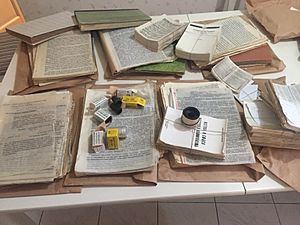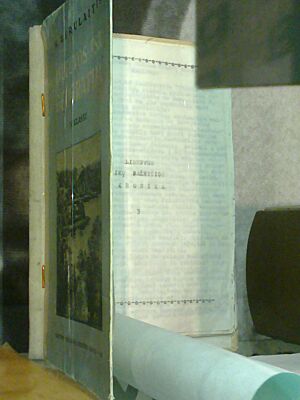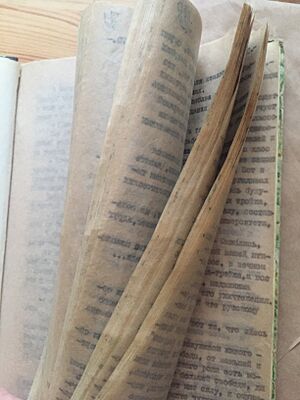Samizdat facts for kids
Quick facts for kids Samizdat |
|

Russian samizdat and photo negatives of unofficial literature
|
|
| Russian | самиздат |
|---|---|
| Romanization | samizdat |
| Literal meaning | self-publishing |
Samizdat (pronounced sah-mee-zdat) was a special way people in the Soviet Union and other Eastern European countries secretly shared books and writings that the government didn't allow. Imagine copying a book by hand or with a typewriter, then passing it to a friend, who passes it to another, and so on. This was a clever way for people to read and share ideas that the government had censored, meaning they tried to stop people from seeing them. It was like a secret underground library!
Contents
What Does Samizdat Mean?
The word samizdat comes from two Russian words: sam (meaning 'self' or 'by oneself') and izdat (which is short for 'publishing house'). So, it literally means 'self-published'.
In Ukraine, there was a similar term called samvydav.
A Russian poet named Nikolay Glazkov made a joke about it in the 1940s. He typed his poems and wrote "Myself by Myself Publishers" on the front page.
Sometimes, books that were secretly sent out of the country and published abroad were called Tamizdat. Tam means 'there' in Russian.
In Poland, people called their secret publishing system the "second circuit."
How Was Samizdat Made?
It was very hard to print anything without the government knowing. For a long time, offices even had to show examples of their typewriters' writing styles to the KGB (the Soviet secret police). This way, the KGB could trace any typed document back to its source.
When photocopy machines appeared, the government made it very difficult to use them without special permission. So, people mostly used their own typewriters. They would often make several copies at once using carbon paper or thin tissue paper. These materials were cheap and easy to hide. Then, these copies would be passed around among trusted friends and networks.
The Look of Samizdat
Samizdat books and papers looked very different from official books. They were often hand-typed, sometimes blurry, wrinkled, and had spelling mistakes. They usually had plain covers. This unique look wasn't planned; it was because people had very few resources and needed to keep their activities secret.
Over time, this rough appearance became a symbol of freedom and rebellion. It showed how resourceful and brave people were in the Soviet Union. The act of reading a samizdat text became a special, secret act.
Who Read Samizdat?
Samizdat started among educated people in Russia who were unhappy with the government. Most of these writings were for other educated people. Even though not many copies were made (around 200,000 readers on average), many readers were important people in culture and government. Surprisingly, many government officials also read samizdat because they needed to know what was being said to censor it!
History of Samizdat
People in Russia have a long history of self-publishing. But samizdat as we know it really took off after Joseph Stalin died. With strict government censorship, people turned to these underground writings to express themselves and understand their world.
Important Samizdat Books
One of the first full-length books to be shared as samizdat was Boris Pasternak's novel Doctor Zhivago in 1957. Even though parts of it were published officially, the full book was banned and spread secretly.
Another famous example is Aleksandr Solzhenitsyn's One Day in the Life of Ivan Denisovich. Even though it was officially published, it was very hard to find, so many copies were made and shared through samizdat.
In the mid-1950s, poetry became very popular. Poems by both famous and unknown writers were shared. Some early samizdat magazines like Sintaksis (1959–1960) and Phoenix (1961) published these poems. The people who ran these magazines often held public poetry readings in Moscow. However, the authorities soon stopped these gatherings, and some writers were arrested for "anti-Soviet agitation."
Not all samizdat was political. For example, the poet Joseph Brodsky was even charged with "social parasitism" (meaning he wasn't doing useful work) because his poems circulated in samizdat.
After a famous trial in 1965 involving writers Yuli Daniel and Andrei Sinyavsky, the government became even stricter. This led to more political samizdat, which became very important for the dissident movement.
Samizdat Magazines
The earliest samizdat magazines were mostly about literature. Later, from 1964 to 1970, historian Roy Medvedev published The Political Journal, which had analyses that later appeared in the West.
The most famous and longest-running samizdat magazine was A Chronicle of Current Events. It focused on reporting accurate information about human rights issues in the USSR. From 1968 to 1982, 65 issues were published. The anonymous editors encouraged readers to send in information from their local areas.
The Chronicle was known for its clear, factual style. It had sections like "Arrests, Searches, Interrogations" and "In Prisons and Camps." The editors believed their publication was legal under the Soviet Constitution, but the authorities disagreed. Many people involved in the Chronicle's production were harassed, arrested, or forced to leave the country.
In the late 1980s, as the Soviet Union began to change, there was a new wave of samizdat magazines. These included Glasnost and Ekspress-khronika.
What Kinds of Topics Did Samizdat Cover?
Samizdat covered many topics, but mainly literature, religion, national identity, and politics. The government censored many types of books, even detective novels and science fiction, so these also appeared in the underground.
One study of a large samizdat archive showed that most texts were political (62%), followed by religious (20%) and nationalist (17%). Literary works were also important, even if they made up a smaller percentage of the archive.
Literary Samizdat
In its early days, samizdat was mostly about literature. This included poetry, classic Russian books that couldn't be published, and famous foreign books. When Boris Pasternak's Doctor Zhivago was banned, its secret sharing helped define samizdat. Later, Alexander Solzhenitsyn's famous book about the prison camps, The Gulag Archipelago, also led to a big increase in samizdat activity.
Political Samizdat
Most samizdat texts were about politics. These often included personal statements, appeals, protests, or information about arrests and trials. Some also analyzed problems in the USSR and suggested different ways the government could handle things.
There wasn't one single political idea in samizdat. Authors debated from many different viewpoints, including socialist, democratic, and Slavophile (a group that valued Russian traditions and culture).
Socialist writers compared the government to the ideals of Marxism and hoped for reforms. They wanted to make socialism more "human." However, when the Soviet Union invaded Czechoslovakia in 1968 (an event called the "Prague Spring"), it crushed hopes for reform. This made samizdat focus more on completely different political systems.
Democratic samizdat writers believed that the political system needed a big change to become a democracy. They usually supported peaceful, gradual changes.
Slavophile samizdat was different. These writers believed that democracy and socialism were Western ideas that didn't fit Eastern European culture. They focused on Russian nationalism and the importance of Russian traditions and the Orthodox Church. However, some of their views were not inclusive and caused divisions.
Religious Samizdat
Many religious groups, including Orthodox, Catholic, Baptist, and Pentecostal, created samizdat texts. Even though there were many Muslims in the USSR, there are no known Islamic samizdat texts.
National Samizdat
Jewish samizdat often called for an end to the unfair treatment of Jews in the USSR. Some also expressed a wish to move to Israel. This movement also discussed broader human rights for Soviet citizens.
Other groups like the Crimean Tatars, Volga Germans, and Meskhetian Turks also created samizdat. They protested the government's refusal to let them return to their homelands after Joseph Stalin's death. Ukrainian samizdat spoke out against the idea that Russian culture was better than Ukrainian culture and condemned the forced use of the Russian language.
Secret Audio Recordings
Besides written samizdat, there were also secret audio recordings.
Ribs or "bone records" were homemade phonograph records copied from forbidden recordings smuggled into the country. These were often Western rock and roll, jazz, or music by banned Russian artists. They were made from used X-ray film, which was cheap and available. These records were thin, flexible, and could be played on a normal record player.
Magnitizdat was the sharing of sound recordings on audio tape. This was often music by Russian folk singers (called bards), Western artists, and underground music groups. Magnitizdat became more popular than "bone records" because it was cheaper, easier to copy, and had better sound quality.
Later Influence
The idea of samizdat has even influenced the world of computers. For example, when a famous computer book containing important code was no longer allowed to be officially distributed, illegal copies of it circulated for years. This act of copying was often called "samizdat" in the computer world. It shows how the term came to mean sharing important information that is hard to get.
Important Samizdat Magazines
- A-YA
- Chronicle of Current Events
- Chronicle of the Catholic Church in Lithuania
- Phoenix
- Sintaksis
See also
 In Spanish: Samizdat para niños
In Spanish: Samizdat para niños
- Eastern Bloc media and propaganda
- Human rights in the Soviet Union
- Political repression in the Soviet Union
- Shadow library
- Underground press




